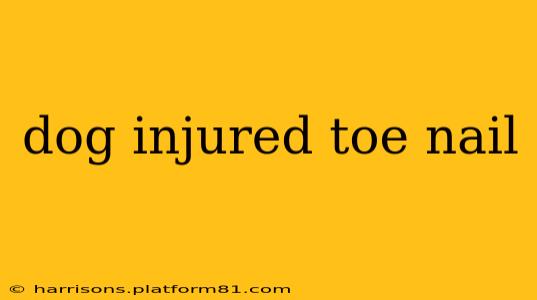A seemingly minor injury like a damaged toenail can cause significant discomfort for your canine companion. Understanding the causes, recognizing the symptoms, and knowing how to properly treat a dog's injured toenail is crucial for responsible pet ownership. This comprehensive guide will walk you through everything you need to know about dealing with this common canine ailment.
What are the signs of a damaged toenail in dogs?
Noticing the signs of a damaged toenail is the first step in providing appropriate care. Common symptoms include:
- Bleeding: Obvious bleeding is a clear indication of a serious injury.
- Limping: Your dog may limp or favor the affected paw, showing reluctance to put weight on it.
- Swelling: The area around the nail may appear swollen and red.
- Lameness: This can range from mild discomfort to severe pain, depending on the severity of the injury.
- Whining or yelping: Your dog may vocalize when the injured toe is touched.
- Changes in nail appearance: The nail might be cracked, broken, or have a noticeably jagged edge.
What causes a dog's toenail to become injured?
Several factors can lead to a dog's toenail injury. These include:
- Traumatic injuries: This is the most common cause. Things like getting their nails caught on something (carpet, furniture, etc.), stepping on sharp objects (glass, rocks), or being involved in a fight can all damage toenails.
- Overgrown nails: Long, overgrown nails are more prone to snagging and breaking. Regular nail trimming is essential for prevention.
- Underlying conditions: In some cases, underlying conditions like nail bed infections or tumors can weaken the nails, making them more susceptible to injury.
How do I treat my dog's injured toenail?
Treatment depends on the severity of the injury. For minor injuries like a small crack or chip:
- Clean the wound: Gently clean the area with a mild antiseptic solution.
- Stop the bleeding: Apply gentle pressure to the area using a clean cloth or gauze until the bleeding stops. You may need to apply a styptic powder specifically designed for pets to help clot the bleeding.
- Monitor for infection: Keep an eye on the wound for signs of infection, such as increased swelling, redness, pus, or a foul odor. If you see any of these signs, consult your veterinarian immediately.
For more serious injuries requiring veterinary attention:
- Severe bleeding: If the bleeding is profuse or doesn't stop after applying pressure, seek immediate veterinary care.
- Deep lacerations: If the nail is deeply lacerated or there's exposed bone or tissue, veterinary intervention is essential.
- Signs of infection: As mentioned above, any signs of infection warrant a veterinary visit.
- Fractured nail: A veterinarian will need to assess the extent of the damage and may need to remove a portion or all of the affected nail.
My dog is licking his injured toenail excessively. Is this normal?
Excessive licking can indicate pain or an attempt to clean the wound. While some licking is normal, excessive licking can lead to further irritation and increase the risk of infection. A veterinarian-approved Elizabethan collar (cone) can help prevent your dog from licking the injured area.
How can I prevent my dog from injuring their toenails?
Prevention is key! Here's how you can protect your dog's toenails:
- Regular nail trims: Keep your dog's nails trimmed regularly to prevent them from getting too long and snagging.
- Paw protection: Use booties or paw protectors during walks, especially in rough terrain or areas with potential hazards.
- Careful walks: Be mindful of your dog's surroundings during walks to avoid sharp objects or uneven surfaces.
- Observe for signs of injury: Regularly check your dog's paws for any signs of injury, redness, or swelling.
When should I take my dog to the vet for an injured toenail?
It's always best to err on the side of caution. Schedule a vet appointment if:
- The bleeding is severe or doesn't stop.
- Your dog shows signs of significant pain or discomfort.
- There's any sign of infection (swelling, redness, pus).
- The nail is deeply lacerated or broken.
- Your dog is limping excessively.
By understanding the signs, causes, treatment, and prevention of injured toenails, you can ensure your canine companion remains happy, healthy, and pain-free. Remember, early intervention is crucial for successful treatment and preventing complications. Always consult your veterinarian if you have any concerns.
